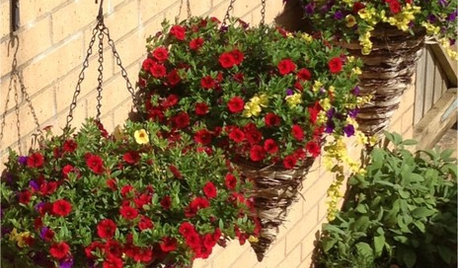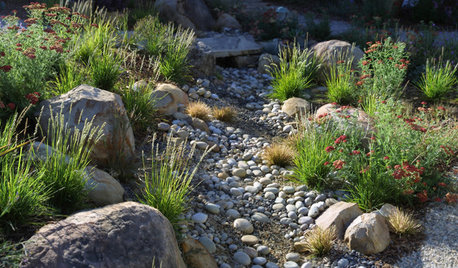Container Soils - Water Movement & Retention XII
I first posted this thread back in March of '05. Eleven times previous, it has reached the maximum number of posts GW allows to a single thread, which is much more attention than I ever imagined it would garner. I have reposted it, in no small part because it has been great fun, and a wonderful catalyst in the forging of new friendships and in increasing my list of acquaintances with similar growing interests. The forum and email exchanges that stem so often from the subject are, in themselves, enough to make me hope the subject continues to pique interest, and the exchanges provide helpful information. Most of the motivation for posting this thread another time comes from the participants' reinforcement of the idea that some of the information provided in good-spirited collective exchange will make/has made some degree of difference in the quality of many readers' growing experience.
I'll provide links to some of the more recent of the previous eleven threads and nearly 1,800 posts at the end of what I have written - in case you have interest in reviewing them. Thank you for taking the time to examine this topic - I hope that any/all who read it take at least something interesting and helpful from it. I know it's long; my hope is that you find it worth the read.
Container Soils - Water Movement and Retentioncolor>size>
A Discussion About Soilscolor>size>
As container gardeners, our first priority should be to insure the soils we use are adequately aerated for the life of the planting, or in the case of perennial material (trees, shrubs, garden perennials), from repot to repot. Soil aeration/drainage is the most important consideration in any container planting. Soils are the foundation that all container plantings are built on, and aeration is the very cornerstone of that foundation. Since aeration and drainage are inversely linked to soil particle size, it makes good sense to try to find and use soils or primary components with particles larger than peat/compost/coir. Durability and stability of soil components so they contribute to the retention of soil structure for extended periods is also extremely important. Pine and some other types of conifer bark fit the bill nicely, but I'll talk more about various components later.
What I will write also hits pretty hard against the futility in using a drainage layer of coarse materials as an attempt to improve drainage. It just doesn't work. All it does is reduce the total volume of soil available for root colonization. A wick can be employed to remove water from the saturated layer of soil at the container bottom, but a drainage layer is not effective. A wick can be made to work in reverse of the self-watering pots widely being discussed on this forum now.
Since there are many questions about soils appropriate for use in containers, I'll post basic mix recipes later, in case any would like to try the soil. It will follow the Water Movement information.
Consider this if you will:
Soil fills only a few needs in container culture. Among them are: Anchorage - A place for roots to extend, securing the plant and preventing it from toppling. Nutrient Retention - It must retain enough nutrients in available form to sustain plant systems. Gas Exchange - It must be sufficiently porous to allow air to move through the root system and by-product gasses to escape. Water - It must retain water enough in liquid and/or vapor form to sustain plants between waterings. Most plants can be grown without soil as long as we can provide air, nutrients, and water, (witness hydroponics). Here, I will concentrate primarily on the movement of water in soil(s).
There are two forces that cause water to move through soil - one is gravity, the other capillary action. Gravity needs little explanation, but for this writing I would like to note: Gravitational flow potential (GFP) is greater for water at the top of the container than it is for water at the bottom. I'll return to that later.
Capillarity is a function of the natural forces of adhesion and cohesion. Adhesion is water's tendency to stick to solid objects like soil particles and the sides of the pot. Cohesion is the tendency for water to stick to itself. Cohesion is why we often find water in droplet form - because cohesion is at times stronger than adhesion; in other words, water's bond to itself can be stronger than the bond to the object it might be in contact with; in this condition it forms a drop. Capillary action is in evidence when we dip a paper towel in water. The water will soak into the towel and rise several inches above the surface of the water. It will not drain back into the source, and it will stop rising when the GFP equals the capillary attraction of the fibers in the paper.
There will be a naturally occurring "perched water table" (PWT) in containers when soil particulate size is under about .125 (1/8) inch. This is water that occupies a layer of soil that is always saturated & will not drain from the portion of the pot it occupies. It can evaporate or be used by the plant, but physical forces will not allow it to drain. It is there because the capillary pull of the soil at some point will surpass the GFP; therefore, the water does not drain, it is said to be 'perched'. The smaller the size of the particles in a soil, the greater the height of the PWT. This water can be tightly held in heavy (comprised of small particles) soils and 'perch' (think of a bird on a perch) just above the container bottom where it will not drain; or, it can perch in a layer of heavy soil on top of a coarse drainage layer, where it will not drain.
Imagine that we have five cylinders of varying heights, shapes, and diameters, each with drain holes, and we fill them all with the same soil mix, then saturate the soil. The PWT will be exactly the same height in each container. This saturated area of the container is where roots initially seldom penetrate & where root problems frequently begin due to a lack of aeration. Water and nutrient uptake are also compromised by lack of air in the root zone. Keeping in mind the fact that the PWT height is dependent on soil particle size and has nothing to do with height or shape of the container, we can draw the conclusion that: Tall growing containers will always have a higher percentage of unsaturated soil than squat containers when using the same soil mix. The reason: The level of the PWT will be the same in each container, with the taller container providing more usable, air holding soil above the PWT. From this, we could make a good case that taller containers are easier to grow in.
A given volume of large soil particles has less overall surface area when compared to the same volume of small particles and therefore less overall adhesive attraction to water. So, in soils with large particles, GFP more readily overcomes capillary attraction. They drain better. We all know this, but the reason, often unclear, is that the height of the PWT is lower in coarse soils than in fine soils. The key to good drainage is size and uniformity of soil particles. Mixing large particles with small is often very ineffective because the smaller particles fit between the large, increasing surface area which increases the capillary attraction and thus the water holding potential. An illustrative question: How much perlite do we need to add to pudding to make it drain well?
We have seen that adding a coarse drainage layer at the container bottom does not improve drainage. It does though, reduce the volume of soil required to fill a container, making the container lighter. When we employ a drainage layer in an attempt to improve drainage, what we are actually doing is moving the level of the PWT higher in the pot. This simply reduces the volume of soil available for roots to colonize. Containers with uniform soil particle size from top of container to bottom will yield better and more uniform drainage and have a lower PWT than containers using the same soil with drainage layers.
The coarser the drainage layer, the more detrimental to drainage it is because water is more (for lack of a better scientific word) reluctant to make the downward transition because the capillary pull of the soil above the drainage layer is stronger than the GFP. The reason for this is there is far more surface area on soil particles for water to be attracted to in the soil above the drainage layer than there is in the drainage layer, so the water perches. I know this goes against what most have thought to be true, but the principle is scientifically sound, and experiments have shown it as so. Many nurserymen employ the pot-in-pot or the pot-in-trench method of growing to capitalize on the science.
If you discover you need to increase drainage, you can simply insert an absorbent wick into a drainage hole & allow it to extend from the saturated soil in the container to a few inches below the bottom of the pot, or allow it to contact soil below the container where the earth acts as a giant wick and will absorb all or most of the perched water in the container, in most cases. Eliminating the PWT has much the same effect as providing your plants much more soil to grow in, as well as allowing more, much needed air in the root zone.
In simple terms: Plants that expire because of drainage problems either die of thirst because the roots have rotted and can no longer take up water, or they starve/"suffocate" because there is insufficient air at the root zone to insure normal water/nutrient uptake and root function.
Bark fines of fir, hemlock or pine, are excellent as the primary component of your soils. The lignin contained in bark keeps it rigid and the rigidity provides air-holding pockets in the root zone far longer than peat or compost mixes that too quickly break down to a soup-like consistency. Conifer bark also contains suberin, a lipid sometimes referred to as nature's preservative. Suberin, more scarce as a presence in sapwood products and hardwood bark, dramatically slows the decomposition of conifer bark-based soils. It contains highly varied hydrocarbon chains and the microorganisms that turn peat to soup have great difficulty cleaving these chains.
To confirm the existence of the PWT and how effective a wick is at removing it, try this experiment: Fill a soft drink cup nearly full of garden soil. Add enough water to fill to the top, being sure all soil is saturated. Punch a drain hole in the bottom of the cup and allow the water to drain. When drainage has stopped, insert a wick into the drain hole . Take note of how much additional water drains. Even touching the soil with a toothpick through the drain hole will cause substantial additional water to drain. The water that drains is water that occupied the PWT. A greatly simplified explanation of what occurs is: The wick or toothpick "fools" the water into thinking the pot is deeper than it is, so water begins to move downward seeking the "new" bottom of the pot, pulling the rest of the water in the PWT along with it. If there is interest, there are other simple and interesting experiments you can perform to confirm the existence of a PWT in container soils. I can expand later in the thread.
I always remain cognizant of these physical principles whenever I build a soil. I have not used a commercially prepared soil in many years, preferring to build a soil or amend one of my 2 basic mixes to suit individual plantings. I keep many ingredients at the ready for building soils, but the basic building process usually starts with conifer bark and perlite. Sphagnum peat plays a secondary role in my container soils because it breaks down too quickly to suit me, and when it does, it impedes drainage and reduces aeration. Size matters. Partially composted conifer bark fines (pine is easiest to find and least expensive) works best in the following recipes, followed by uncomposted bark in the Note that there is no sand or compost in the soils I use. Sand, as most of you think of it, can improve drainage in some cases, but it reduces aeration by filling valuable macro-pores in soils. Unless sand particle size is fairly uniform and/or larger than about BB size, I leave it out of soils. Compost is too fine and unstable for me to consider using in soils. The small amount of micro-nutrients it supplies can easily be delivered by one or more of a number of chemical or organic sources that do not detract from drainage/aeration.
My Basic Soils ....
5 parts pine bark fines (partially composted fines are best)
1 part sphagnum peat (not reed or sedge peat please)
1-2 parts perlite
garden lime (or gypsum in some cases)
controlled release fertilizer (if preferred)
micro-nutrient powder, other source of micro-nutrients, or fertilizer with all nutrients - including minors
Big batch:
2-3 cu ft pine bark fines
5 gallons peat
5 gallons perlite
2 cups dolomitic (garden) lime (or gypsum in some cases)
2 cups CRF (if preferred)
1/2 cup micro-nutrient powder (or other source of the minors - provided in some fertilizers)
Small batch:
3 gallons pine bark
1/2 gallon peat
1/2 gallon perlite
4 tbsp lime (or gypsum in some cases)
1/4 cup CRF (if preferred)
micro-nutrient powder (or other source of the minors)
I have seen advice that some highly organic (practically speaking - almost all container soils are highly organic) container soils are productive for up to 5 years or more. I disagree and will explain why if there is interest. Even if you were to substitute fir bark for pine bark in this recipe (and this recipe will long outlast any peat based soil) you should only expect a maximum of two to three years life before a repot is in order. Usually perennials, including trees (they're perennials too) should be repotted more frequently to insure vigor closer to their genetic potential. If a soil is desired that will retain structure for long periods, we need to look more to inorganic components. Some examples are crushed granite, fine stone, coarse sand (see above - usually no smaller than BB size in containers, please), Haydite, lava rock (pumice), Turface, calcined DE, and others.
For long term (especially woody) plantings and houseplants, I use a superb soil that is extremely durable and structurally sound. The basic mix is equal parts of pine bark, Turface, and crushed granite.
1 part uncomposted screened pine or fir bark (1/8-1/4")
1 part screened Turface
1 part crushed Gran-I-Grit (grower size) or #2 cherrystone
1 Tbsp gypsum per gallon of soil
CRF (if desired)
Source of micro-nutrients or use a fertilizer that contains all essentials
I use 1/8 -1/4 tsp Epsom salts per gallon of fertilizer solution when I fertilize (check your fertilizer - if it is soluble, it is probable it does not contain Ca or Mg.
If there is interest, you'll find some of the more recent continuations of the thread at the links below:
Post XI
Post X
Post IX
Post VIII
Post VII
If you feel you were benefited by having read this offering, you might also find this thread about Fertilizing Containerized Plants helpful, as well.
As always - best luck.
Al

















Woebegonia
meyermike_1micha
Related Professionals
Beachwood Landscape Architects & Landscape Designers · Braintree Landscape Contractors · Olympia Landscape Contractors · Oviedo Landscape Contractors · Parker Landscape Contractors · Ramsey Landscape Contractors · Ronkonkoma Landscape Contractors · Aventura Window Contractors · Laurel Window Contractors · Linthicum Window Contractors · Peoria Fence Contractors · Arcadia Fence Contractors · Castro Valley Fence Contractors · Lockport Fence Contractors · Hermosa Beach Fence Contractorstapla (mid-Michigan, USDA z5b-6a)Original Author
jodik_gw
Woebegonia
ligreenthumb
greenman28 NorCal 7b/8a
tapla (mid-Michigan, USDA z5b-6a)Original Author
ligreenthumb
ligreenthumb
jodik_gw
tapla (mid-Michigan, USDA z5b-6a)Original Author
greenman28 NorCal 7b/8a
ligreenthumb
tapla (mid-Michigan, USDA z5b-6a)Original Author
jodik_gw
tapla (mid-Michigan, USDA z5b-6a)Original Author
ligreenthumb
tapla (mid-Michigan, USDA z5b-6a)Original Author
jodik_gw
JerryVentura Jordan
jojosplants
tapla (mid-Michigan, USDA z5b-6a)Original Author
JerryVentura Jordan
tapla (mid-Michigan, USDA z5b-6a)Original Author
JerryVentura Jordan
tapla (mid-Michigan, USDA z5b-6a)Original Author
ligreenthumb
jodik_gw
AprilAugust
greenman28 NorCal 7b/8a
edweather USDA 9a, HZ 9, Sunset 28
tapla (mid-Michigan, USDA z5b-6a)Original Author
edweather USDA 9a, HZ 9, Sunset 28
tapla (mid-Michigan, USDA z5b-6a)Original Author
edweather USDA 9a, HZ 9, Sunset 28
tapla (mid-Michigan, USDA z5b-6a)Original Author
edweather USDA 9a, HZ 9, Sunset 28
tapla (mid-Michigan, USDA z5b-6a)Original Author
jojosplants
GrnThum
meyermike_1micha
edweather USDA 9a, HZ 9, Sunset 28
tapla (mid-Michigan, USDA z5b-6a)Original Author
edweather USDA 9a, HZ 9, Sunset 28
GrnThum
meyermike_1micha
Kinder Devonshire
tapla (mid-Michigan, USDA z5b-6a)Original Author
tapla (mid-Michigan, USDA z5b-6a)Original Author